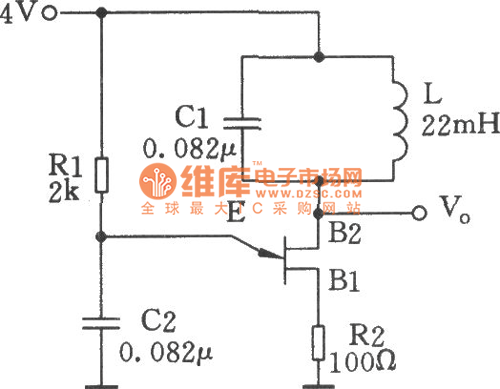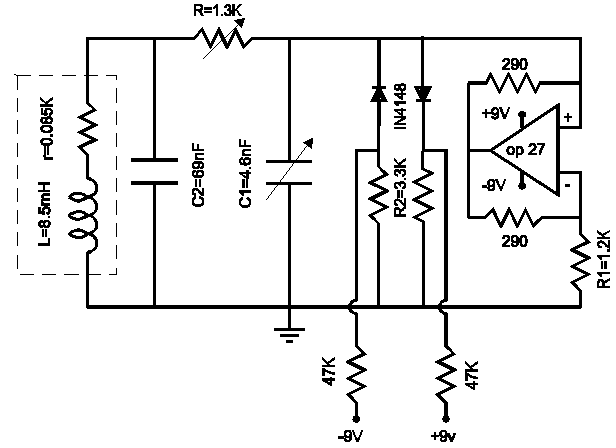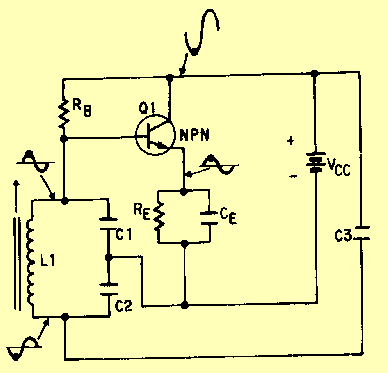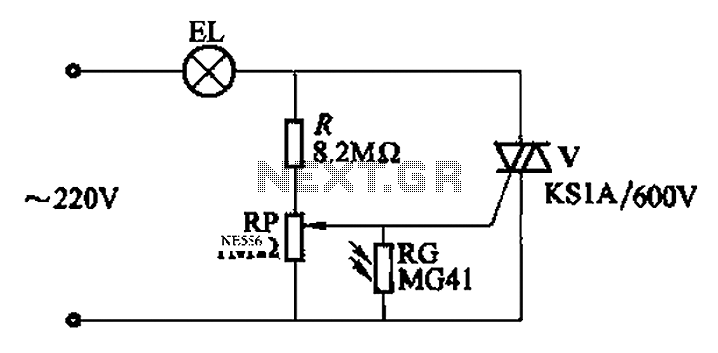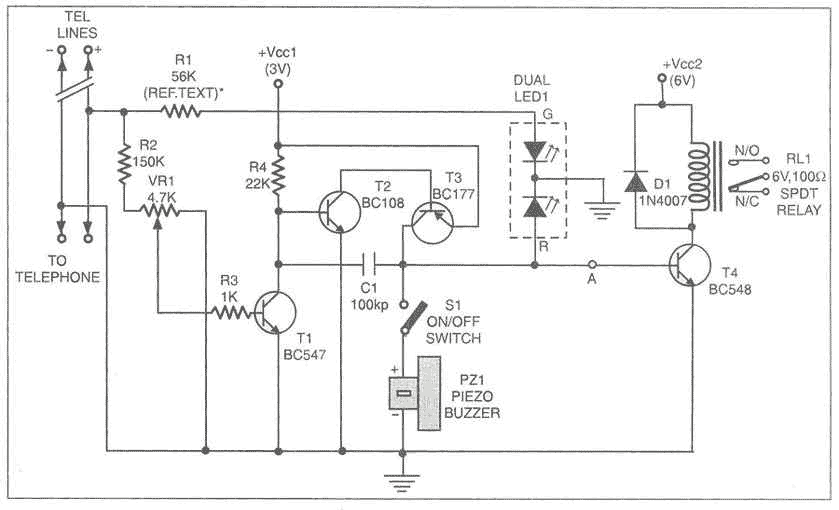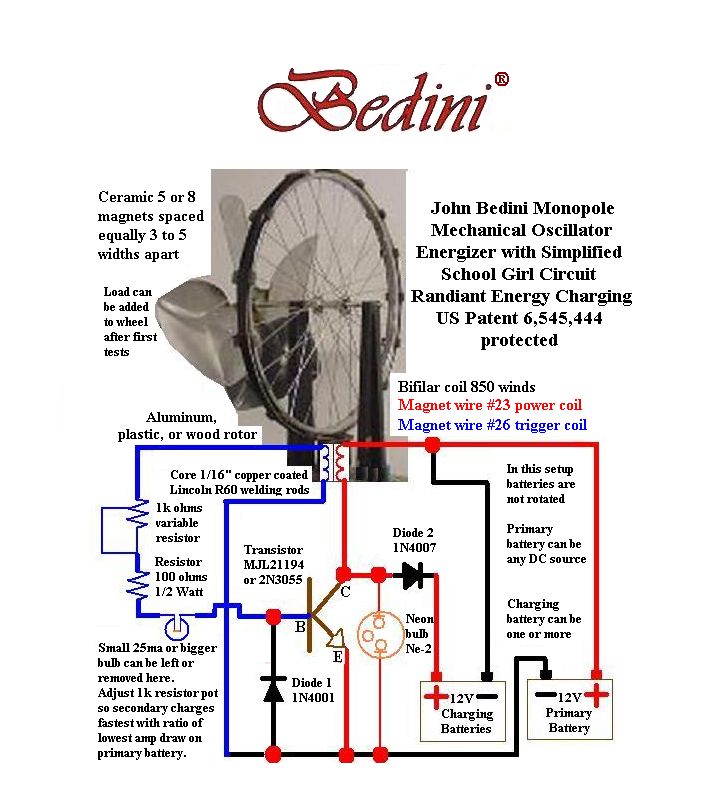
Oscillator operates from one cell
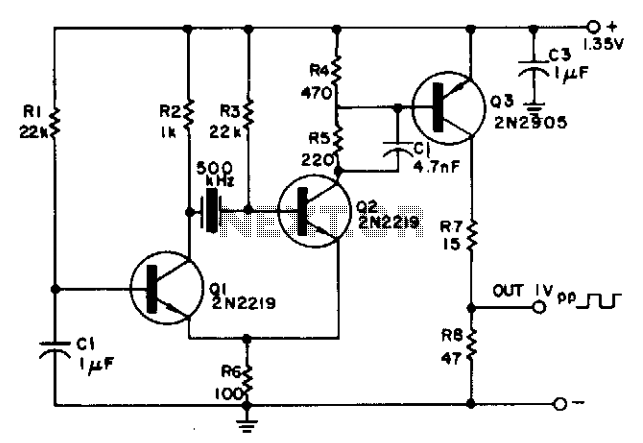
The circuit is powered by a single 1.35 V mercury cell and provides a 1 V square-wave output. The crystal acts as a tuned circuit between transistors Q1 and Q2, which are connected in a common-emitter configuration. Positive feedback is provided through resistor R, enabling oscillation. The signal at the collector of Q2 is squared by Q3, which operates between cutoff and saturation. Resistor R7 ensures short-circuit-proof operation.
The described circuit functions as an oscillator generating a square wave output. The power supply is a 1.35 V mercury cell, which is an essential component as it provides the necessary voltage for the circuit's operation. The output voltage is stabilized at 1 V, making it suitable for various applications that require a square wave signal.
Transistors Q1 and Q2 are configured in a common-emitter arrangement, which is standard for amplification and oscillation purposes. The use of a crystal in the tuned circuit allows for precise frequency control, as crystals exhibit high Q factors, ensuring that the oscillation frequency remains stable and accurate. The positive feedback loop established through resistor R is crucial for initiating and maintaining the oscillation process. The feedback reinforces the input signal, allowing the circuit to sustain oscillations.
Transistor Q3 is employed to shape the output signal. By switching between cutoff and saturation, Q3 effectively converts the analog oscillating signal from the collector of Q2 into a digital square wave. This switching action is critical for generating a clean square-wave output, which can be used in various digital applications.
Resistor R7 plays a protective role in the circuit. It ensures that the circuit can withstand short-circuit conditions without damage, enhancing the reliability of the overall design. This feature is particularly important in practical applications where circuit conditions can change unexpectedly.
Overall, the combination of these components and configurations results in a robust oscillator circuit capable of producing a stable square-wave output, suitable for use in timing applications, signal generation, and other electronic functions requiring a reliable square wave signal.The circuit is powered by a single 1.35 V mercury cell and provides a 1 V square-wave output. As shown, the crystal is a tuned circuit between transistors Ql and Q2, which are connected in the common-emitter configuration. Positive feedback provided by means of R permits oscillation. The signal at the collector of Q2 is squared by Q3, which switches between cutoff and saturation. R7 permits short-circuit-proof operation. 🔗 External reference
The described circuit functions as an oscillator generating a square wave output. The power supply is a 1.35 V mercury cell, which is an essential component as it provides the necessary voltage for the circuit's operation. The output voltage is stabilized at 1 V, making it suitable for various applications that require a square wave signal.
Transistors Q1 and Q2 are configured in a common-emitter arrangement, which is standard for amplification and oscillation purposes. The use of a crystal in the tuned circuit allows for precise frequency control, as crystals exhibit high Q factors, ensuring that the oscillation frequency remains stable and accurate. The positive feedback loop established through resistor R is crucial for initiating and maintaining the oscillation process. The feedback reinforces the input signal, allowing the circuit to sustain oscillations.
Transistor Q3 is employed to shape the output signal. By switching between cutoff and saturation, Q3 effectively converts the analog oscillating signal from the collector of Q2 into a digital square wave. This switching action is critical for generating a clean square-wave output, which can be used in various digital applications.
Resistor R7 plays a protective role in the circuit. It ensures that the circuit can withstand short-circuit conditions without damage, enhancing the reliability of the overall design. This feature is particularly important in practical applications where circuit conditions can change unexpectedly.
Overall, the combination of these components and configurations results in a robust oscillator circuit capable of producing a stable square-wave output, suitable for use in timing applications, signal generation, and other electronic functions requiring a reliable square wave signal.The circuit is powered by a single 1.35 V mercury cell and provides a 1 V square-wave output. As shown, the crystal is a tuned circuit between transistors Ql and Q2, which are connected in the common-emitter configuration. Positive feedback provided by means of R permits oscillation. The signal at the collector of Q2 is squared by Q3, which switches between cutoff and saturation. R7 permits short-circuit-proof operation. 🔗 External reference
